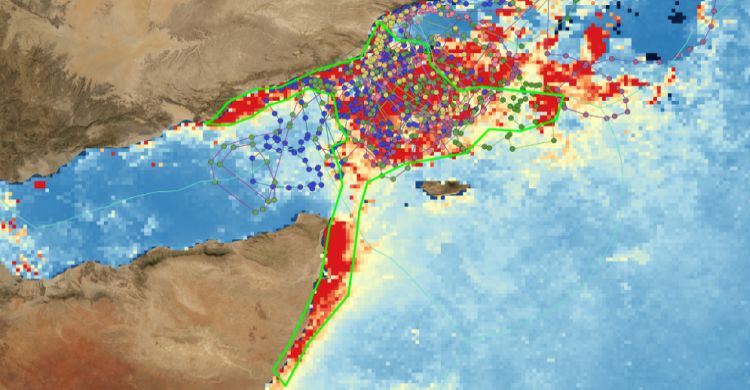North-west Indian Ocean Experts meet to Identify Ecologically or Biologically Significant Marine Areas

Graphic: Courtesy of CSIRO and Dr ALan Rees
Abu Dhabi 26 April 2015 - At the invitation of the Government of the United Arab Emirates (UAE), marine experts from 15 Northwest Indian Ocean countries participated in a regional workshop to describe marine areas meeting criteria developed under the Convention on Biological Diversity (CBD) for ecologically or biologically significant marine areas (EBSAs). The week-long workshop in Dubai was hosted by the UAE’s Ministry of Environment and Water, and organized by the CBD Secretariat with support from CMS Office – Abu Dhabi, which is hosted by Environment Agency – Abu Dhabi on behalf of the Government of the UAE. Twelve of the participating countries were either CMS Parties and/or signatories to one or more CMS agreements.
Marine migratory species – waterbirds and seabirds, sharks and rays, whales and dolphins, dugongs and marine turtles – represent the region’s extraordinary marine biodiversity at its most visible and charismatic. According to Lyle Glowka, Executive Coordinator of CMS Office – Abu Dhabi, “These animals connect the region’s ecosystems, countries and cultures. They make an important contribution to ecosystem structure and function and ultimately contribute to the well-being of the region’s peoples.”
At least four of the seven CBD EBSA criteria correlate strongly with marine migratory species and, as a study commissioned by CMS Office – Abu Dhabi has demonstrated, migratory marine species have been either a principle or contributing factor in the description of at least 80 per cent of the over 200 EBSAs identified to date under the CBD EBSA process, which has now reviewed more than 70 per cent of the Earth’s total ocean surface. What is more, the information used to describe EBSAs may be useful in developing ecological networks that can contribute to the needs of migratory marine species and promote connectivity. For these reasons the 11th Meeting of the CMS Conference of the Parties (Quito, November 2014) recognized in Resolution 11.25 (Advancing Ecological Networks to Address the Needs of Migratory Species) the value and importance of the CBD EBSA process in supporting the work of CMS.
Experts at the meeting described 31 marine areas as meeting the EBSA criteria. Migratory species correlated strongly with 30 of the 31 areas described. Most proposals were for marine areas in national waters, but proposals also included transboundary areas as well as marine areas located beyond the limits of national jurisdiction as well. Notable examples include the Southern Red Sea Pelagic Area (Yemen, Sudan and Eritrea), the Southern Red Sea Island Archipelagos Area (Yemen and Eritrea), the Great Whirl and Adjacent Eddies (including Eastern Yemen and the area of Somalia south of the Horn of Africa) (pictured), the Socotra Archipelago, the Oman Arabian Sea Coast between Dhofar and Ras Al Had, the Arabian Basin and the Arabian Sea Oxygen Minimum Zone two pelagic marine areas located beyond the limits of national jurisdiction. In addition important new information shared at the workshop could guide future work in India, Oman and Pakistan to survey the abundance and establish the migratory routes of Arabian Sea Humpback Whales. Humpback whales are listed on CMS Appendix I and are a Concerted Action species
A number of important areas were described by Kuwait and UAE. Pakistan and Iran also described important areas, one shared by the two countries. India described the Angria Bank as an EBSA representing the largest coral reef area in the country.
The workshop learned about the rich marine biodiversity throughout the Red Sea and Gulf of Aden. Areas were described as EBSAs by Egypt, Sudan, Eritrea and Djibouti. The outcomes of the workshop may provide a basis to intensify efforts to survey dugongs and cetaceans to determine their abundance. The area is also important for sharks, marine turtles and birds.
The materials prepared for and the relationships established at the workshop will be a rich resource that will support the Convention’s work globally such as the CMS Programme of Work on Cetaceans, and will guide more focused activities to support implementation of the CMS Dugongs and Sharks Memoranda of Understanding (MOU), and the CMS IOSEA Marine Turtle MOU.
When finalized the workshop report will be forwarded to the CBD Subsidiary Body for Scientific, Technical and Technological Advice for review and then to the CBD Conference of the Parties (Mexico, November 2016). Later on, the report will be provided to the United Nations General Assembly.
The workshop brought together a wide range of expertise from throughout the region and internationally. “We will all look back on this meeting as a watershed event that brought the region closer together in a common pursuit to promote international cooperation to conserve marine biodiversity and migratory marine species,” noted Glowka.
Last updated on 19 Octobre 2015


